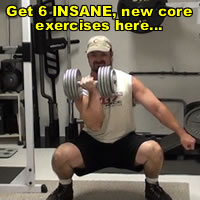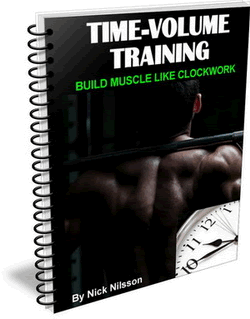The Abdominal Crunch is the simplest and most common exercise for the six-pack abs.
Being the most common abdominal exercise also means it is the abdominal exercise that is most often done incorrectly. Proper form is simple and the Crunch can be an effective ab exercise.
How to do Abdominal Crunches:
Lie down flat on your back with your knees bent and your feet on the floor. Hold your hands wherever you feel comfortable (on your chest or beside your head - just be sure you don't pull on your head).
The typical crunch is taught by instructing you to simply curl your upper torso forward, bringing your rip cage towards your pelvis. Squeeze the abs hard at the top.
To increase the effectiveness of the crunch movement, push your chest and head up towards the ceiling pushing your lower back flat onto the floor. Your anatomy will automatically cause you to follow a crunching pattern.
Trying to crunch up towards the ceiling will increase the tension on the abs.
Tricks for Performing Abdominal Crunches More Effectively:
1. Keep it in line
Keep your head and neck in line with the spine. Don't let your chin touch your chest. This takes the focus off the abs and can strain your neck.
2. The negative
Most people forget the negative or lowering part of the crunch. Fight gravity on the way down to really get a burn.
3. Breathing for a smaller waist
At the top when you're squeezing, hold your body up and breathe in and out a few times, trying to relax every other muscle except the abs.
- This will intensify the contraction, increasing your results.
- It will also help to tighten the abdominal area.
- While you are contracting the abs continuously, the deeper fibers are relaxing and contracting while you breathe.
- Each time the deep fibers relax, your abs will squeeze them in a little more, making your waist smaller.
- While this is temporary smallness, you are teaching the muscles of your abdominals to tighten up.
4. Anchoring your feet
Never anchor your feet (e.g. have someone hold them down or wedge them under something) when you're doing any kind of ab work. This automatically activates the hip flexors (the muscles that lie just across the hip joint that serve to bring the thighs towards the abs).
5. Feet on a bench
Some people like to put their feet up on a bench when doing crunch. Be aware that this also activates the hip flexors.
- If you do want to do these, keep your heels about six inches apart and touch your toes together.
- This will minimize hip flexor involvement.
- Also, push down with your heels to activate the glutes and hamstrings.
- These muscles directly oppose the action of the hips flexors and will keep hip flexor involvement to a minimum
6. Push with heels
At the top of the crunch movement, push with your heels to tilt the pelvis up slightly, lifting your tailbone off the floor a little. This increases lower ab involvement and increases the contraction by moving the pelvis closer to the ribcage.
7. Feet in the air
Try to crunch with your feet up in the air and your knees bent like you're sitting.
- Crunch upward instead of towards your knees for a different way of hitting the muscle.
- Imagine as though you are trying to press your face onto the ceiling.
- You may even wish to reach up with your hands as though making palm prints on the ceiling.
- This will help you lead with your shoulders.
- This has a different feel than the typical crunch which focuses on simply bring the ribcage to the pelvis.
8. Lengthwise on a bench
Try doing crunches lying lengthwise on a bench. Slide yourself down to the end of the bench to that the upper part of your torso is hanging off (the edge should be just below your shoulder blades). This will give you a greater range of motion by allowing you to flex your upper back around the end of the bench. Don't go so far back that you fall off though.
9. Increasing crunch difficulty
To increase the difficulty of a regular crunch, place your feet on a low step (about 6 inches), point your toes and press your heels against the surface of the step as you crunch. This contracts your hamstrings, which relaxes your hip flexors, forcing your abs to work harder.
Common Errors in the Abdominal Crunch:
1. Not squeezing the abs
The crunch is an exercise that can be done in what looks like a correct manner but resulting in no meaningful work. Be sure to squeeze the abs very hard at the top of each crunch. If you can talk to somebody (and be easily understood) while doing crunches, you are probably not squeezing hard enough.
2. Yanking on the back of the head
Yanking on the back of the head can lead to neck pain. If you have a tendency to do this, keep your hands off to the sides of your head without actually letting them touch your head.
3. Using momentum and elastic rebound
This is often done in an effort to get out of the bottom to return to the top. Each rep should be performed slowly and under control. This muscular tension is what will work the abs best.
4. Holding the breath
Don't hold your breath all the time when doing ab work. The abdominals play an important role in breathing. By limiting breathing, you will be limiting the work on your abs.
5. Interlocking fingers behind the head
Interlocking your fingers behind your head limits the range of motion of your abs by tying it to shoulder and lat flexibility. If you have tight shoulders and do this you won't be able to stretch back as far. Keep your hands and forearms off your head.
I would also recommend the Abdominal Sit-Up exercise for working the six-pack abs.
![]()
More From Fitstep.com
| How to Do Your First Chin-Up | |
| How to Spot Reduce Stomach Fat | |
| The Funniest Fitness Pics From Around the Web | |
| Flatten Your Pooch Belly With This Easy Exercise |
Share This Page...
---
Home -> Exercise Library -> Abdominal Exercises -> Ab Crunches



